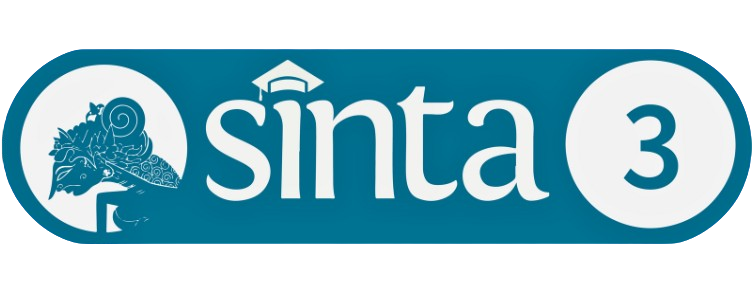Hubungan Antara Mental Toughness dengan Kecemasan Kompetitif pada Atlet Bola Basket Profesional
Downloads
Tujuan dari penelitian ini untuk mengetahui adanya hubungan antara mental toughness dengan kecemasan kompetitif pada atlet bola basket profesional di Indonesia. Partisipan penelitian merupakan atlet basket profesional (N=54). Pengumpulan data menggunakan metode survei melalui Google Form. Variabel mental toughness diukur menggunakan instrumen yang disusun oleh penulis. Variabel kecemasan kompetitif diukur menggunakan instrumen Competitive State Anxiety Inventory-2 (CSAI-2). Data dianalisis menggunakan teknik korelasi Pearson Product-Moment. Hasil penelitian menunjukkan terdapat hubungan negatif antara mental toughness dengan kecemasan kompetitif dimensi cognitive anxiety (r(54)=-0,586; p=0,000) dan mental toughness dengan kecemasan kompetitif dimensi somatic anxiety (r(54)=-0,615; p=0,000). Terdapat hubungan positif antara mental toughness dengan kecemasan kompetitif dimensi self-confidence (r(54)=0,493; p=0,000). Dapat disimpulkan bahwa terdapat hubungan yang signifikan antara mental toughness dengan ketiga dimensi kecemasan kompetitif pada atlet bola basket profesional di Indonesia.
Adisasmito, L. (2007). Mental Juara Modal Atlet Berprestasi. Raja Grafindo Persada.
Algani, P. W., Yuniardi, M. S., & Masturah, A. N. (2018). Mental Toughness dan Competitive Anxiety pada Atlet Bola Voli. Jurnal Ilmiah Psikologi Terapan, 06(01), 93–101. https://doi.org/10.22219/jipt.v6i1.5433
Ananda, A. (2021). "DBL Effect” di PON Papua. 2021. Diambil 9 November 2021, dari https://www.mainbasket.com/r/11372/dbl-effect-di-pon-papua
Ardiansyah, B. (2014). Dampak Kecemasan pada Atlet Bola Basket Sebelum Bertanding. Jurnal Phederal Penjas.
Brown, D. J., & Fletcher, D. (2017). Effects of Psychological and Psychosocial Interventions on Sport Performance: A Meta-Analysis. Sports Medicine, 47(1), 77–99. https://doi.org/10.1007/s40279-016-0552-7
Cheng, W. N. K., & Hardy, L. (2016). Three-dimensional model of performance anxiety: Tests of the adaptive potential of the regulatory dimension of anxiety. Psychology of Sport and Exercise, 22, 255–263. https://doi.org/10.1016/j.psychsport.2015.07.006
Ciptaningtyas, T. (2012). Program intervensi imagery untuk mengatasi kecemasan kompetitif pada atlet bulutangkis dewasa. [Tesis, Universitas Indonesia].
Gay, L. R.; Diehl, P. L. (1992). Research Methods for Business and Management. Mc. Millan Publishing Company.
Gucciardi, D. F., Gordon, S., & Dimmock, J. A. (2008). Towards an understanding of mental toughness in Australian football. Journal of Applied Sport Psychology, 20(3), 261–281. https://doi.org/10.1080/10413200801998556
Gucciardi, D. F., Gordon, S., & Dimmock, J. A. (2009). Development and preliminary validation of a mental toughness inventory for Australian football. Psychology of Sport and Exercise, 10(1), 201–209. https://doi.org/10.1016/j.psychsport.2008.07.011
Gucciardi, D. F., & Jones, M. I. (2012). Beyond optimal performance: Mental toughness profiles and developmental success in adolescent cricketers. Journal of Sport & Exercise Psychology, 34(1), 16–36.
Jarvis, M. (2006). Sport psychology: A student's handbook. In Sport Psychology: A Student's Handbook. Routledge. https://doi.org/10.4324/9780203965214
Jones, E. S., Mullen, R., & Hardy, L. (2019). Measurement and validation of a three factor hierarchical model of competitive anxiety. Psychology of Sport and Exercise, 43(January 2018), 34–44. https://doi.org/10.1016/j.psychsport.2018.12.011
Jones, G., Hanton, S., & Connaughton, D. (2002). What is this thing called mental toughness? An investigation of elite sport performers. Journal of Applied Sport Psychology, 14(3), 205–218. https://doi.org/10.1080/10413200290103509
Judge, L. W., Urbina, L. J., Hoover, D. L., Craig, B. W., Judge, L. M., Leitzelar, B. M., Pearson, D. R., Holtzclaw, K. A., & Bellar, D. M. (2016). The impact of competitive trait anxiety on collegiate powerlifting performance. Journal of Strength and Conditioning Research, 30(9), 2399–2405. https://doi.org/10.1519/JSC.0000000000001363
Kalinin, R., Balázsi, R., Péntek, I., Duică, Ștefania, & HanÈ›iu, I. (2019). Relationship between competitive anxiety and mental toughness: a latent regression analysis. Health, Sports & Rehabilitation Medicine, 20(2), 70–74. https://doi.org/10.26659/pm3.2019.20.2.70
Kanniyan, A. (2015). Competitive state anxiety: Impact of positive self-talk training on junior level football players. Sport Mont, 13, 42–50.
Kuik, R. (2019). Mental Health & Athletes. http://www.athletesforhope.org/2019/05/mental-health-and-athletes/
Kumar, A. (2016). A study on mental toughness and sports competition anxiety for male and female basketball players. International Journal of Physical Education, Sports and Health, 3(2), 379–381. www.kheljournal.com
Martens, R., Vealey, R. S., & Burton, D. (1990). Competitive Anxiety in Sport. Human Kinetics.
Mellalieu, S. D., Hanton, S., & Fletcher, D. (2006). A Competitive Anxiety Review: Recent Directions in Sport Psychology Research. Nova Science Publishers, Inc.
Milavić, B., Jurko, D., & Grgantov, Z. (2013). Relations of competitive state anxiety and efficacy of young volleyball players. Collegium antropologicum, 37 Suppl 2(September 2015), 83–92. http://www.ncbi.nlm.nih.gov/pubmed/23914493
Mottaghi, M., Atarodi, A., & Rohani, Z. (2013). The Relationship between Coaches' and Athletes' Competitive Anxiety, and their Performance. Iran J Psychiatry Behav Sci, 7(2), 68–76.
Neil, R.; Wilson, K.; Mellalieu, S. D.; Hanton, S.; Taylor, J. (2012). Competitive anxiety intensity and interpretation: A two-study investigation into their relationship with performance. International Journal of Sport and Exercise Psychology, 10(2), 96–111.
Ong, N. C. H., & Chua, J. H. E. (2021). Effects of psychological interventions on competitive anxiety in sport: A meta-analysis. Psychology of Sport and Exercise, 52, 101836. https://doi.org/10.1016/j.psychsport.2020.101836
Rachman, S. (2021). 5 Tim Ramaikan Pendaftaran Peserta Baru IBL 2022. https://www.suara.com/sport/2021/08/12/223249/5-tim-ramaikan-pendaftaran-peserta-baru-ibl-2022
Raynadi, F. B., Rachmah, D. N., & Akbar, S. N. (2016). Hubungan Ketangguhan Mental Dengan Kecemasan Bertanding Pada Atlet Pencak Silat Di Banjarbaru. Jurnal Ecopsy, 3(3), 149–154.
Retnoningsasy, E. & M. J. (2020). Hubungan Antara Mental Toughness Dengan Kecemasan Olahraga Pada Atlet Badminton. Jurnal Penelitian Psikologi, Fakultas Ilmu Pendidikan, UNESA, 7(3), 8–15.
Rice, S. M., Purcell, R., De Silva, S., Mawren, D., McGorry, P. D., & Parker, A. G. (2016). The Mental Health of Elite Athletes: A Narrative Systematic Review. Sports Medicine, 46(9), 1333–1353. https://doi.org/10.1007/s40279-016-0492-2
Robazza, C., & Bortoli, L. (2007). Perceived impact of anger and anxiety on sporting performance in rugby players. Psychology of Sport and Exercise, 8(6), 875–896. https://doi.org/10.1016/j.psychsport.2006.07.005
Rocha, V. V. S., & Osório, F. de L. (2018). Associations between competitive anxiety, athlete characteristics and sport context: Evidence from a systematic review and meta-analysis. Revista de Psiquiatria Clinica, 45(3), 67–74. https://doi.org/10.1590/0101-60830000000160
Schaefer, J., Vella, S. A., Allen, M. S., & Magee, C. A. (2016). Competition Anxiety, Motivation, and Mental Toughness in Golf. Journal of Applied Sport Psychology, 28(3), 309–320. https://doi.org/10.1080/10413200.2016.1162219
Spielberger, C. D. (1966). Anxiety and Behavior. Academic Press.
Thelwell, R., Weston, N., & Greenlees, I. (2005). Defining and understanding mental toughness within soccer. Journal of Applied Sport Psychology, 17(4), 326–332. https://doi.org/10.1080/10413200500313636
Weinberg, R., & Butt, J. (2011). Building mental toughness. In Mental Toughness in Sport: Developments in Theory and Research (hal. 212–229). Routledge.
Weinberg, R., & Daniel, G. (2019). Foundations of Sport and Exercise Psychology 7th Ed.
Woodman, T. . H. L. (2001). Stress and anxiety. In Handbook of research on sport psychology. Wiley.
BRPKM is a periodical publication with open access to the Creative Commons Attribution 4.0 International (CC-BY 4.0). Therfore, the copyright remains with the author.
With this license, anyone has the right to use the information and to re-distribute the content contained in this journal for any purpose, including commercial purposes. It can be done as long as it fulfills two conditions, namely; (1) you shall provide attribution by citing the original link source, and state if any changes have been made; and (2) you may not use any legal provisions or technological means of control that can legally restrict others from doing the things that are permitted by this license.
Journal editors will not ask the author to approve the transfer of copyright on all published manuscripts.










